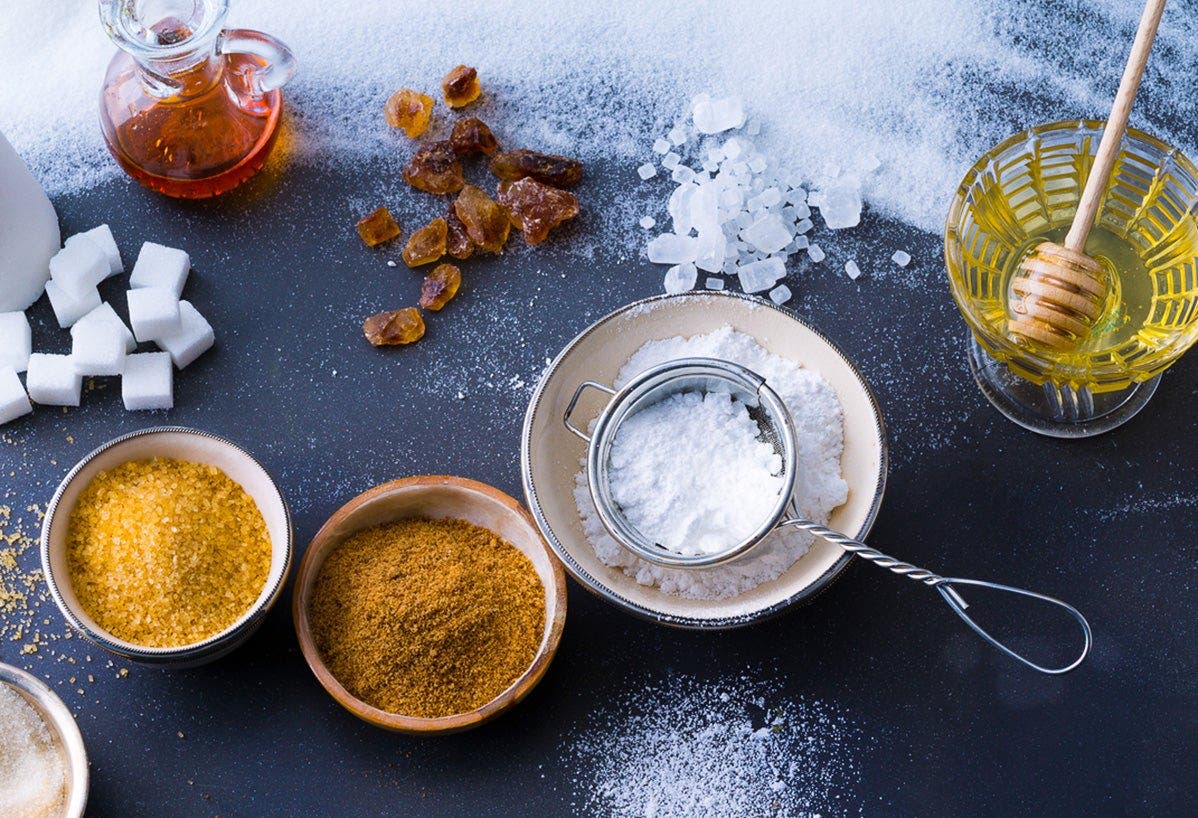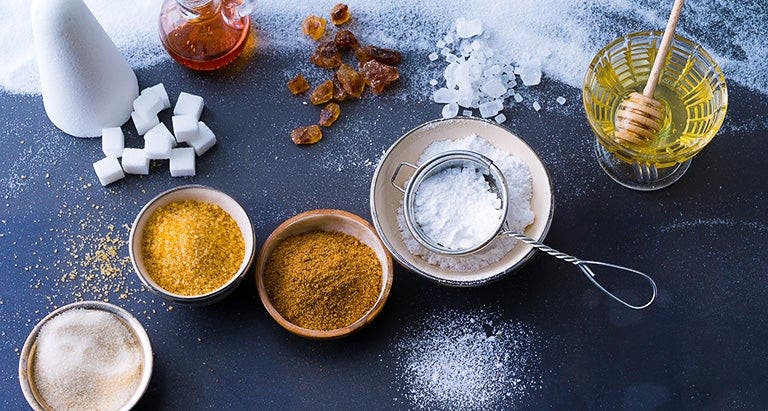When to use sugar vs. other sweeteners


In this article:
1/ White sugar
2/ Brown sugar
3/ Molasses
4/ Honey
5/ Agave
6/ Monk fruit
9/ Is any sweetener healthier than the others?
10/ The bottom line
Walk down the baking aisle of your supermarket and all of the sweetener options can be overwhelming. Even plain old sugar comes in a variety of colors and textures, plus there are syrupy options like molasses, honey, agave syrup, several calorie-free sweeteners, and now a growing variety of “natural” sweeteners from monk fruit and coconut. So when should you use which one?
Here’s the scoop on more than a dozen types of sweeteners, plus expert tips from a recipe developer on how to best use each one.
White sugar
Granulated sugar, the ubiquitous white stuff used for baking and to sweeten a cup of coffee, comes from the sugar cane or sugar beet plant. It’s a crucial ingredient in baking since it helps food to brown and caramelize, provides flavor and texture, and enhances creaminess. “It doesn’t have much flavor on its own, but it really enhances the flavor of the foods it’s paired with,” says recipe developer Ronne Freedman.
While regular granulated sugar is used often in cooking and baking, it’s not the only white sugar out there, since the stuff also comes in different textures and sizes. Coarse grain sugar is used for decorating, while superfine sugar (made by passing regular sugar through a sieve) is typically used in beverages, gelatins, glazes, and meringues.
Powdered sugar, also known as confectioner’s sugar or icing sugar, is made by grinding regular granulated sugar to a fine powder and is commonly used to make icing and frosting, and to dust over baked goods. Powdered sugar typically contains added cornstarch to help prevent clumping.
Brown sugar
Brown sugar is formed during the late stages of sugar processing. It gets its color and distinct taste from its molasses content which varies by type: light brown sugar contains 3.5% molasses, while dark brown sugar contains 6.5% molasses. If a recipe doesn’t specify light or dark brown sugar, opt for the light variety because “it has a milder, caramel flavor, so it’s preferred in most cookies, breads and crisps,” says Freedman.
Brown sugar is very sensitive to moisture loss, so once its bag is opened, keep the package airtight as well as possible. To soften brown sugar that’s hardened, place some (in a bowl, not its plastic bag) in the microwave with a small bowl of water and heat for about a minute; if it’s still hard, give it another 30 seconds.
Recipes often give a packed or unpacked amount. To pack the sugar, press it down into the measuring cup with your hand.
Turbinado sugar is typically sold under the brand name “Sugar in the Raw.” It has large, light crystals that can generally be swapped one-for-one for brown sugar in recipes.
Muscovado sugar has much smaller crystals and has a strong molasses flavor, even more so than regular dark brown sugar, “so use it when you want an earthy note,” says Freedman.
Molasses
Molasses is a thick syrup made from either sugar cane or sugar beet. It imparts a “heavy, sweet earthy flavor, so it’s great in barbeque sauce,” says Freedman. There are three grades of molasses: mild (very sweet), dark (less sweet with a slight bitter taste), and blackstrap (very nutrient dense because it’s boiled three times; it’s even sold in health food stores as a supplement). Blackstrap is a good source of iron, calcium, magnesium, and potassium; one tablespoon of blackstrap molasses contains 20% of the iron you need each day.
Molasses imparts a strong flavor — and dark color— to baked goods but is not as sweet as sugar, so if you want to replace some sugar with molasses (not more than half the sugar in a recipe), use a ratio of 1 1/3 cup of molasses to 1 cup of sugar. Make sure to decrease the liquids in the recipe by about 1/3 cup.
Honey
Honey is natural (thanks, bees), and as a result, it varies in color, taste, and texture depending on the type of nectar collected by the bees who made it. “Use the darker, deeper honeys (sage, buckwheat, wild flower) for baking breads, glazing meats, and topping frozen desserts,” says Freedman. “Use light herbal flower honeys (sage, lavender, orange blossom, red clover, wild flower) in teas, for baking cookies, for fruity desserts, and in light glazes.”
Because honey tastes sweeter than white granulated sugar, you can use less of it in a recipe than you would sugar: substitute 3/4 cup plus 1 tablespoon of honey for each cup of sugar (but slightly scale back on the other liquids in the recipe by about 2 tablespoons).
To easily remove honey from measuring spoons and cups, Freedman recommends first coating them with cooking spray.
Agave
Agave syrup starts as juice from the agave plant that is then processed and concentrated to form a sugary liquid that’s slightly thinner than honey. It’s popular with vegans as a honey replacement and makes a great sweetener for cold beverages since it dissolves easily into cold liquids, unlike honey and sugar.
Light agave nectar has a mild taste, amber nectar lends a moderate caramel-like flavor, and dark agave nectar has a much stronger caramel flavor. While light agave is best in delicate dessert recipes, baked goods, and cold beverages, amber and dark nectars work in both sweet and savory dishes.
To bake with agave, use 1/3 cup of agave syrup for every cup of sugar in the recipe and decrease the amount of liquid in the recipe. Some cooks also recommend decreasing the oven temperature by 25ºF.
Monk fruit
Monk fruit is a small, round fruit native to southern China, and the sweetener is extracted from its juice. The taste is over 100 times sweeter than sugar, but it has no calories, and even contains antioxidants. It comes in powder or liquid forms, is FDA approved, and can be used in baking as a sugar substitute. Just make sure to read the ingredient list to make sure it’s just monk fruit, since this sweetener is sometimes mixed with erythritol, a sugar alcohol that can cause bloating or an upset stomach.
Coconut sugar
Made from coconut palm tree sap, coconut sugar has a low glycemic index, so it impacts your blood sugar less than typical white granulated sugar. It’s also more nutritious than regular sugar because it contains vitamins (C and E), minerals (zinc, iron, potassium), and antioxidants. Coconut sugar typically comes in large, coarse granules and tastes similar to brown sugar. It can replace white sugar 1:1 when cooking or baking and works well for moist cakes and chewy cookies, since it retains moisture well.
No-calorie sweeteners
Aspartame is a Food and Drug Administration (FDA)-approved artificial sweetener sold under the names Equal and Nutrasweet. It’s about 180 times sweeter than sugar but doesn’t work when heated, so skip it for cooking and baking; it’s best used in beverages and no-bake desserts and puddings. It has been approved by the FDA.
Two other popular no-calorie sweeteners work for baking though: Splenda and stevia. Splenda, the brand name for sucralose, is made from sugar, but the body can’t digest it, so it doesn’t provide any calories. It’s approved by the FDA and is about 600 times sweeter than sugar. Splenda is sold as a granulated powder and works well in cooking and baking. You can substitute Splenda cup-for-cup for sugar in recipes.
The other baking and cooking option for no-calorie sweeteners is stevia, which is harvested from a wild herb and is anywhere from 100 to 300 times sweeter than sugar. It’s sold in powder and liquid form and works well in cooking and baking. It’s approved by the FDA and is known by brand names Truvia and PureVia.
Is any sweetener healthier than the others?
There’s a lot of hype online about natural sweeteners that come from plants — like honey or maple syrup — being somehow healthier than more processed sweeteners because they have naturally-occurring vitamins or minerals. But the truth is, to get any meaningful amounts of micronutrients, you’d need to consume so much of it…and that benefit wouldn’t outweigh the amount of the Points, calories, and added sugars in consuming a ton of that sweetener.
In the end, there isn’t one sweetener that rises above the rest as “better for you.” All of the sweeteners we mention here that have calories (white sugar, brown sugar, molasses, honey, agave, monkfruit, and coconut sugar) are considered added sugars and will use Points, so you want to be mindful of how much you're consuming and limit added sugars to 10% or less of your daily calories.
“Many people consume more added sugar than is recommended, though, and having too much added sugar has been linked to a higher risk of obesity, diabetes, and cardiovascular disease,” says Christie Sauer, M.S., RDN. “Sweeteners that have zero calories may help you stay within your daily Points Budget, reduce your intake of added sugars, and help with weight loss.”
The bottom line
There are tons of different options to explore besides plain old granulated white sugar. Other sweeteners might add a more interesting flavor, bring out a better texture, or lessen an item’s caloric impact; feel free to branch out with the sweeteners you use in your cooking and baking.
This content is for informational purposes only and does not constitute medical advice, diagnosis or treatment. It should not be regarded as a substitute for guidance from your healthcare provider.
WeightWatchers relies on only the most trustworthy sources, including highly credentialed experts, government and academic institutions, peer-reviewed studies, and respected medical associations. We focus on primary sources and research that is recent, relevant, and high-quality. For more about how we report, write, and fact check our stories, please see our editorial policy.
Granulated sugars: U.S. Department of Agriculture (2019). “Sugars, granulated.” https://fdc.nal.usda.gov/food-details/746784/nutrientsSugars when baking: Sugar Association (2020). “Sugar in baking: What bakers need to know.” https://www.sugar.org/blog/sugar-in-baking-what-bakers-need-to-know/
How and when to use sugars: King Arthur Baking Company (2023). “A guide to different types of sugars: How to use them and when to substitute.” https://www.kingarthurbaking.com/blog/2023/03/21/a-guide-to-different-types-of-sugars-how-to-use-them-and-when-to-substitute
Sugar types and terms: WebMD (2023). “What is turbinado sugar?” https://www.webmd.com/diet/what-is-turbinado-sugar
What is molasses: Medical News Today (2023). “Everything you need to know about molasses.” https://www.medicalnewstoday.com/articles/318719
Blackstrap molasses nutrition: WebMd (2022). “Blackstrap Molasses: Are There Health Benefits?” https://www.webmd.com/diet/health-benefits-blackstrap-molasses
Honey: University of Arkansas Division of Agriculture (n.d.). “Honey Versus Sugar-Which is Healthier?” https://www.uaex.uada.edu/counties/miller/news/fcs/herbs-spices/Honey%20Versus%20Sugar-Which%20is%20Healthier.aspx#:~:text=In%20honey%2C%20the%20fructose%20and,a%20bit%20sweeter%20than%20sugar.
Agave syrup: National Library of Medicine (2022). “Agave Syrup: Chemical Analysis and Nutritional Profile, Applications in the Food Industry and Health Impacts.” https://pmc.ncbi.nlm.nih.gov/articles/PMC9222424/
Splenda: Healthline (2024). “Sucralose (Splenda): What It Is and Side Effects.” https://www.healthline.com/nutrition/sucralose-good-or-bad
Stevia: Cleveland Clinic (2024). “Stevia is sweet — but is it good for you?” https://health.clevelandclinic.org/what-is-stevia
Aspartame: European Food Safety Authority (2023). “Aspartame.” https://www.efsa.europa.eu/en/topics/topic/aspartame
Monkfruit: Cleveland Clinic (2021). “Is Monk Fruit a Healthy Sweetener?” https://health.clevelandclinic.org/why-you-should-use-monk-fruit-sweetener
Coconut sugar and baking: Martha Stewart (2023). “Yes, You Can Use Coconut Sugar in Place of White Sugar—but Is This Alternative Sweetener Better for You?” https://www.marthastewart.com/8355856/what-is-coconut-sugar
Coconut sugar health: International Journal of Environmental Research and Public Health (2023). “Coconut Sugar: Chemical Analysis and Nutritional Profile; Health Impacts; Safety and Quality Control; Food Industry Applications.”https://pmc.ncbi.nlm.nih.gov/articles/PMC9964017/
